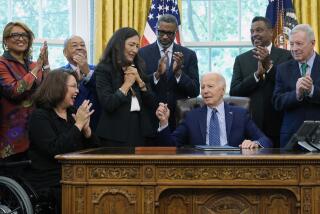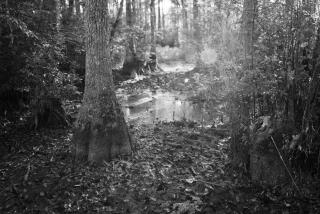On the side streets of Philadelphia, freedom still rings
Philadelphia
The neon-streaked National Constitution Center dazzled. The historic red-brick Independence Hall stirred.
But it wasn’t until I stepped onto the rickety back porch of a Quaker house in northwest Philadelphia that I felt transported.
It was rainy, and I was about to duck back into the house when tour guide Jacqueline Wiggins pointed to a scraggly bush in the corner of the yard.
“I think of those African people,” she said quietly, “hiding behind that boxwood. Waiting to see if it was safe. Hoping it was the right house.”
Philadelphia came alive for me at that moment. I’d driven out here to the cobblestones of Germantown Avenue thinking about bypassing the typical tourist itinerary -- all those grand colonial sites that spoke to the birth of our nation. I wanted to peek in on another moment in our history, when the Civil War loomed and Philadelphia was a hotbed of abolitionism.
This rough-hewn house on Germantown Avenue was a station of the Underground Railroad, a safe haven for slaves fleeing north. It’s said that Harriet Tubman stopped here once. There’s no solid proof of that, but without doubt, many exhausted fugitives took refuge in the cramped attic or the dank outbuilding.
Visitors can take a guided tour that includes a dramatic re-enactment at the Johnson House Historic Site. By all accounts, it’s quite moving. But I found the quiet on that back porch deeply affecting as well.
Inside the Johnson House, there wasn’t so much to see as there was atmosphere to absorb. The two-story home was built in 1768 by the Johnsons, a Quaker family that designed it to be solid but simple, as their faith demanded. Even the mantel is modest -- too narrow to hold so much as a candlestick. The floors and walls are rough, uneven plank.
Glass cases hold a few artifacts, including a slave collar filled with pebbles and hung with iron rings so whoever wore it would rattle and clank if he tried to run.
A beacon for fugitive slaves
You could easily spend an entire day in Germantown, wandering the streets that President George Washington retreated to in 1793, when yellow fever swept through the nation’s capital in nearby Philadelphia. The narrow streets are lined with squat brick colonials and grand Victorian mansions; several are open for tours.
Pressed by a tight timetable, I reluctantly set off for my next stop: Mother Bethel African Methodist Episcopal Church, in the heart of historic Philadelphia.
The Rev. Richard Allen -- a slave who bought his freedom -- purchased the land for Mother Bethel in 1787. It’s said to be the oldest black-owned parcel in the United States.
In Allen’s day, the church building was a rustic blacksmith shop. It was also a beacon. Fugitive slaves knew they would find help here: Members of the congregation would feed and clothe them and point them to sanctuary. If they were lucky, they’d get to hear a sermon too; Allen’s forceful eloquence always packed the house.
After Allen’s death in 1831, the congregation raised funds for a new church building, completed in 1889. It’s breathtaking. Light streams in from the enormous stained-glass windows and dances across dark mahogany pews. The sanctuary’s colors are so warm and jeweled, you almost feel bathed in gold.
Downstairs, you can tour a small museum. One of the church’s early hymnals is here, and Allen’s original wooden pulpit. There’s also a poster warning fugitives -- and those who sympathized with them -- that “three slave-hunters” from Boston were in town, looking for bounty. The poster described the trio in chilling detail: One, it was said, “has a big mouth . . . and a good deal of dirty bushy hair. . . . He looks like a pirate and knows how to be a stealer of men.”
My next stop -- the African American Museum in Philadelphia -- was disappointing. The exhibits felt thin; I found little to hold my interest.
Instead, I hit the National Constitution Center, a $185-million museum that opened in 2003.
Billed as “The Story of We, the People,” the museum bursts with interactive, multimedia razzle-dazzle. To me, it felt hyperactive.
If you can slow down and focus on one exhibit at a time, you’ll find lots of food for thought -- and even a few genuine historic artifacts, such as a rusty set of slave shackles. It’s easy to overlook them, though, amid all the noise and flashing lights.
The museum aims to be kid-friendly, and I could see my own children (who didn’t join me on this trip) delighting in all there is to touch and do.
But if you’re looking for educational value, this is a museum best taken in small doses. Come prepared to study one historical period -- the Civil War, say, or Watergate -- and you’ll learn a great deal about how the Constitution was challenged, and how it held up. Just don’t try to do it all at once.
Washington Square
Looking to clear my head, I strolled over to the Liberty Bell and then to Independence Hall, where a National Park Service ranger vividly sketched the city as the Founding Fathers knew it. Don’t forget to look in next door, at the modest brick hall where George Washington was inaugurated.
The rain had cleared as I left Independence Hall, and I decided to walk a few blocks to Washington Square, a modest patch of green with a powerful history. Many Revolutionary War soldiers are buried here -- including hundreds who died of depravation in British prison camps. Their graves “are enough to make the heart of stone melt away,” John Adams said when he visited in 1777.
After the war, the green became a favorite meeting spot for Africans. Black Philadelphians held their festivals in the park -- dubbed “Congo Square” -- sharing dances, songs and food from their homelands.
A guidebook produced by the state of Pennsylvania advises visitors to “listen for the Djembe drum” of West Africa near the Tomb of the Unknown Soldier in Washington Square.
So I walked up to the eternal flame and stood there a moment, in silence.
A horn honked. A dog barked. A little boy scraped a toy truck over the concrete path.
Behind those noises, I could swear I heard the steady thump of a drumbeat, low and insistent.
Once again, I felt transported.
travel@latimes.com
More to Read
Sign up for The Wild
We’ll help you find the best places to hike, bike and run, as well as the perfect silent spots for meditation and yoga.
You may occasionally receive promotional content from the Los Angeles Times.






